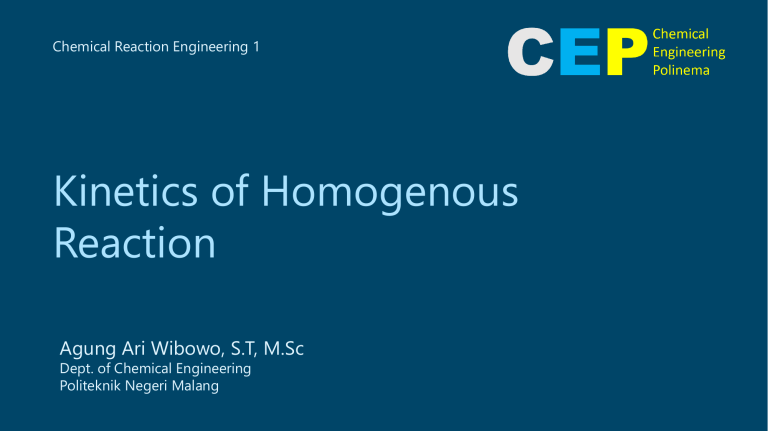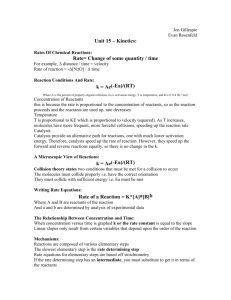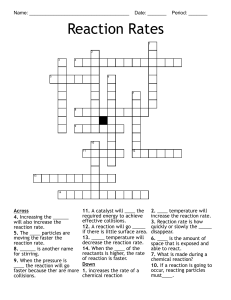
Chemical Reaction Engineering 1 Kinetics of Homogenous Reaction Agung Ari Wibowo, S.T, M.Sc Dept. of Chemical Engineering Politeknik Negeri Malang Homogeneous reactions are chemical reactions in which the reactants and products are in the same phase Batch Reactor Continous Stirred Tank / Mixed Flow Reactor Plug Flow Reactor Reaction rate, the speed at which a chemical reaction proceeds. It is often expressed in terms of either the concentration (amount per unit volume) of a product that is formed in a unit of time or the concentration of a reactant that is consumed in a unit of time 1 𝑑𝑁𝑖 𝑚𝑜𝑙𝑒𝑠 𝑖 𝑓𝑜𝑟𝑚𝑒𝑑 𝑟𝑖 = = 𝑆 𝑑𝑡 (𝑆𝑢𝑟𝑓𝑎𝑐𝑒 𝐴𝑟𝑒𝑎)(𝑡𝑖𝑚𝑒) 1 𝑑𝑁𝑖 𝑚𝑜𝑙𝑒𝑠 𝑖 𝑓𝑜𝑟𝑚𝑒𝑑 𝑟𝑖 = = 𝑉 𝑑𝑡 (𝑣𝑜𝑙 𝑜𝑓 𝑓𝑙𝑢𝑖𝑑)(𝑡𝑖𝑚𝑒) Volume Mass 1 𝑑𝑁𝑖 𝑚𝑜𝑙𝑒𝑠 𝑖 𝑓𝑜𝑟𝑚𝑒𝑑 𝑟𝑖 = = 𝑊 𝑑𝑡 (𝑚𝑎𝑠𝑠 𝑜𝑓 𝑠𝑜𝑙𝑖𝑑)(𝑡𝑖𝑚𝑒) Area Volume 𝑟𝑖 = 1 𝑑𝑁𝑖 𝑚𝑜𝑙𝑒𝑠 𝑖 𝑓𝑜𝑟𝑚𝑒𝑑 = 𝑉 𝑑𝑡 (𝑣𝑜𝑙 𝑜𝑓 𝑟𝑒𝑎𝑐𝑡𝑜𝑟)(𝑡𝑖𝑚𝑒) Consider this reaction 𝑎𝐴 + 𝑏𝐵 → 𝑐𝐶 + 𝑑𝐷 The Rate Equation −𝑟𝐴 = − 1 𝑑𝑁𝐴 𝑚𝑜𝑙𝑒𝑠 𝐴 𝑐𝑜𝑛𝑠𝑢𝑚𝑒𝑑 = 𝑉 𝑑𝑡 (𝑣𝑜𝑙 𝑜𝑓 𝑓𝑙𝑢𝑖𝑑)(𝑡𝑖𝑚𝑒) The Rate Relation − 𝑟𝐴 𝑟𝐵 𝑟𝑐 𝑟𝑑 =− = = 𝑎 𝑏 𝑐 𝑑 Elementary Reaction 𝐴+𝐵 →𝐶 The number of collisions of molecules A with B is proportional to the rate of reaction. But at a given temperature the number of collisions is proportional to the concentration of reactants in the mixture; hence, the rate of disappearance of A is given by -𝑟𝐴 = 𝑘 𝐶𝐴 𝐶𝐵 Non- Elementary Reaction 𝐻2 + 𝐵𝑟2 → 2𝐻𝐵𝑟 When there is no direct correspondence between stoichiometry and rate, then we have nonelementary reactions Elementary Reaction 𝐴+𝐵 →𝐶 The number of collisions of molecules A with B is proportional to the rate of reaction. But at a given temperature the number of collisions is proportional to the concentration of reactants in the mixture; hence, the rate of disappearance of A is given by -𝑟𝐴 = 𝑘 𝐶𝐴 𝐶𝐵 Non- Elementary Reaction 𝐻2 + 𝐵𝑟2 → 2𝐻𝐵𝑟 When there is no direct correspondence between stoichiometry and rate, then we have nonelementary reactions Problem: Levenspiel, Example 1.1 Problem: Levenspiel, Example 1.1 𝑟𝑖 = How to solve? 1 𝑑𝑁𝑖 𝑚𝑜𝑙𝑒𝑠 𝑖 𝑓𝑜𝑟𝑚𝑒𝑑 = 𝑉 𝑑𝑡 (𝑣𝑜𝑙 𝑜𝑓 𝑟𝑒𝑎𝑐𝑡𝑜𝑟)(𝑡𝑖𝑚𝑒) −𝑟𝐻2 = 2.829 x 104 𝑚𝑜𝑙/𝑚3 𝑠 −𝑟𝑂2 = 1.415 x 104 𝑚𝑜𝑙/𝑚3 𝑠 Negative : reactant being comsumed


